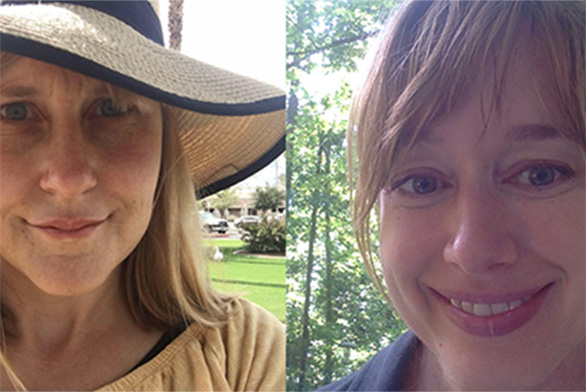Bound by Math
July 21, 2017 | By Anne Kniggendorf (SF97)

Amy Knowles Craig and Sarah Morrison say they didn’t like math in high school. Becoming math teachers was inconceivable, even after freshman math at St. John’s College opened their eyes to the beauty of the subject.
The two women graduated together in 1997 from the Santa Fe campus not having shared a single class. Now, they teach advanced high school math on opposite coasts, but feel bound together by their common career and education.
It was on Facebook about eight years ago when Craig and Morrison really became friends. They were each aware that the other was teaching high school calculus, and Morrison threw out a concern to Craig. Craig wrote back, and they brainstormed about how to make a certain lesson stick in the minds of Morrison’s students.
Their bond has grown ever since.
Craig has taught at Durham Academy in Durham, North Carolina, since 2006 and holds a master’s degree in secondary education from University of North Carolina at Chapel Hill. Morrison has been at Glendale High School near Los Angeles, California, since 2004, and earned a master’s in curriculum and instruction from Boston College.
Craig and Morrison each describe their trajectory from St. John’s to careers in teaching math as accidental, but they also say they love what they’re doing.
In the years between graduation and Durham Academy, Craig did everything from a stint as a cocktail waitress at a piano bar to being a lab tech in pulmonology working with radioactive waste. She says her interest in math became more serious when she was an assistant to a cognitive scientist at Vanderbilt University who studied mathematical thinking.
Even so, Craig was an orchestra teacher at a school in Virginia first, then a math teacher quit. Though she had little experience in math at that point, she stepped up and took the position. She started at Durham Academy with three years of math instruction under her belt.
Morrison worked in a group home for autistic adults and was studying philosophy at Boston College before she decided to try teaching. She wrestled with the idea of studying psychology because of the issues raised in her mind by working with these adults: “What is it to be human? What is it that makes us all the same? Because they were so different,” she recalls.
She says delving into difficult texts at St. John’s gave her the confidence to tackle teaching advanced math even when it was outside her comfort zone. She could have just as easily gone into psychology.
Both women agree, though, that there’s enough psychology that goes into teaching to satisfy them.
“One of our jobs is to help kids feel less embarrassed about their mistakes and help them understand that mistakes help them go to the next step,” Craig says.
The teachers stay in touch to swap trade secrets, like Craig’s turducken trick. A turducken—a turkey, duck, and chicken all cooked together—is not only a Cajun delicacy, but a memorable way to teach the chain rule in calculus.
“So if you want to set the temperature on the stove, you have to think that each of those layers has its own cooking rate,” Morrison explains. “The turducken is a composite function. So its derivative, which represents the rate at which it would cook, is a big multiplication problem with the cooking rates of each layer as factors.”
In a traditional high school setting, these two say, little emphasis is placed on the fact that mathematics is the product of human thought—like the turducken idea. They agree that conventional math holds little charm and is difficult to digest in the faceless, voiceless form it regularly takes.
Craig sees the divisions between levels of math as artificially created as well. She loved that the St. John’s Program contextualized all of math and science, so she does what she can to teach her students in that tradition.
“The dialogue across centuries just blew my mind,” Craig says of her time in math at St. John’s. “And by the time we got to senior year and I was realizing they were all connected—all of the mathematicians were connected to each other—that’s what I want to get through to my kids; that it’s a human creation.”
One of Morrison’s in-class nods to St. John’s is that she keeps her instructional method conversational. The text she uses for calculus is called College Preparatory Mathematics—she’s one of the writers—and is a discovery-type, workshop-approach to math.
Regardless of the level she’s teaching, Morrison has the “strong belief that everybody can do it. It’s just something that humans do; we make sense of things. Trying to get them to believe that is the challenge.”
Morrison agrees, and adds that she sees her students struggle to take the intellectual risk of asking questions. But when they do ask on their own—as in St. John’s classrooms—she knows that’s when the learning happens.

